Important Factors to Consider When Choosing a Superannuation Plan
VerifiedAdded on 2021/05/11
|7
|2309
|64
Report
AI Summary
This report, prepared for a Corporate Financial Management course (FIN200), delves into the intricacies of superannuation plans, crucial for retirement planning. It provides a comparative analysis of two primary types: the defined benefit plan and the investment choice plan. The report elucidates the characteristics, advantages, and disadvantages of each plan. The defined benefit plan, often employer-funded, offers a guaranteed income stream upon retirement, while the investment choice plan provides employees with greater control over their investments. The report also highlights essential factors to consider when selecting a superannuation plan, such as risk tolerance, investment preferences, and long-term financial goals. By exploring these aspects, the report aims to equip individuals with the knowledge needed to make informed decisions about their retirement savings. The report concludes with a recommendation to help employees choose the right plan. It emphasizes the importance of understanding the trade-offs between guaranteed benefits and investment flexibility in order to make the best decision for their individual circumstances.

Assignment Cover Page
Family Name: Gotame
Given Name: Beghanath
Student Number: 12001077
Lecturer’s Name: Masoud AHMADI-PIRSHAHID
Subject Name: FIN200 Corporate Financial Management
Assignment Title: Superannuation
Family Name: Gotame
Given Name: Beghanath
Student Number: 12001077
Lecturer’s Name: Masoud AHMADI-PIRSHAHID
Subject Name: FIN200 Corporate Financial Management
Assignment Title: Superannuation
Paraphrase This Document
Need a fresh take? Get an instant paraphrase of this document with our AI Paraphraser

Title: Important factors to be considered when placing Superannuation
contribution
contribution
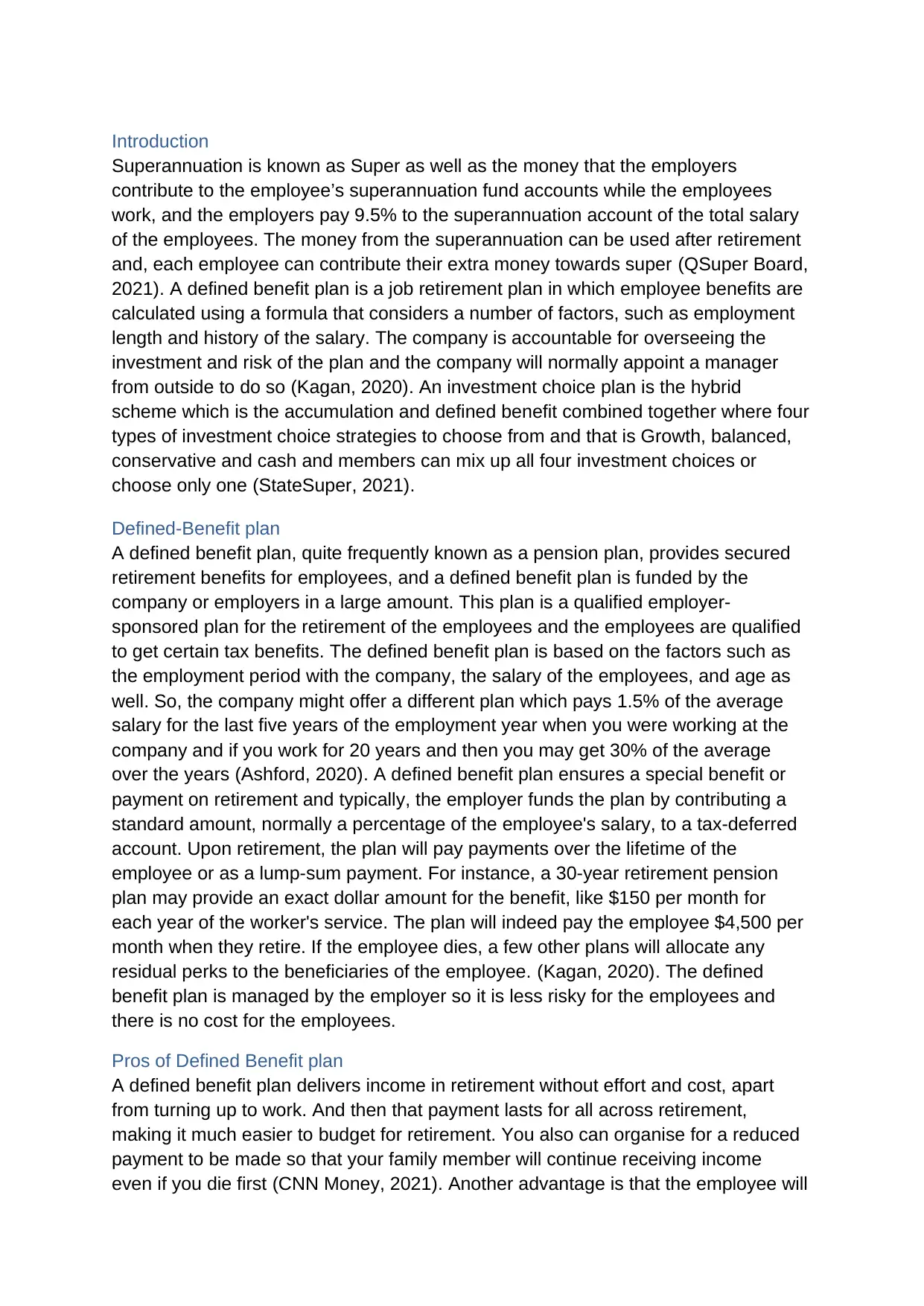
Introduction
Superannuation is known as Super as well as the money that the employers
contribute to the employee’s superannuation fund accounts while the employees
work, and the employers pay 9.5% to the superannuation account of the total salary
of the employees. The money from the superannuation can be used after retirement
and, each employee can contribute their extra money towards super (QSuper Board,
2021). A defined benefit plan is a job retirement plan in which employee benefits are
calculated using a formula that considers a number of factors, such as employment
length and history of the salary. The company is accountable for overseeing the
investment and risk of the plan and the company will normally appoint a manager
from outside to do so (Kagan, 2020). An investment choice plan is the hybrid
scheme which is the accumulation and defined benefit combined together where four
types of investment choice strategies to choose from and that is Growth, balanced,
conservative and cash and members can mix up all four investment choices or
choose only one (StateSuper, 2021).
Defined-Benefit plan
A defined benefit plan, quite frequently known as a pension plan, provides secured
retirement benefits for employees, and a defined benefit plan is funded by the
company or employers in a large amount. This plan is a qualified employer-
sponsored plan for the retirement of the employees and the employees are qualified
to get certain tax benefits. The defined benefit plan is based on the factors such as
the employment period with the company, the salary of the employees, and age as
well. So, the company might offer a different plan which pays 1.5% of the average
salary for the last five years of the employment year when you were working at the
company and if you work for 20 years and then you may get 30% of the average
over the years (Ashford, 2020). A defined benefit plan ensures a special benefit or
payment on retirement and typically, the employer funds the plan by contributing a
standard amount, normally a percentage of the employee's salary, to a tax-deferred
account. Upon retirement, the plan will pay payments over the lifetime of the
employee or as a lump-sum payment. For instance, a 30-year retirement pension
plan may provide an exact dollar amount for the benefit, like $150 per month for
each year of the worker's service. The plan will indeed pay the employee $4,500 per
month when they retire. If the employee dies, a few other plans will allocate any
residual perks to the beneficiaries of the employee. (Kagan, 2020). The defined
benefit plan is managed by the employer so it is less risky for the employees and
there is no cost for the employees.
Pros of Defined Benefit plan
A defined benefit plan delivers income in retirement without effort and cost, apart
from turning up to work. And then that payment lasts for all across retirement,
making it much easier to budget for retirement. You also can organise for a reduced
payment to be made so that your family member will continue receiving income
even if you die first (CNN Money, 2021). Another advantage is that the employee will
Superannuation is known as Super as well as the money that the employers
contribute to the employee’s superannuation fund accounts while the employees
work, and the employers pay 9.5% to the superannuation account of the total salary
of the employees. The money from the superannuation can be used after retirement
and, each employee can contribute their extra money towards super (QSuper Board,
2021). A defined benefit plan is a job retirement plan in which employee benefits are
calculated using a formula that considers a number of factors, such as employment
length and history of the salary. The company is accountable for overseeing the
investment and risk of the plan and the company will normally appoint a manager
from outside to do so (Kagan, 2020). An investment choice plan is the hybrid
scheme which is the accumulation and defined benefit combined together where four
types of investment choice strategies to choose from and that is Growth, balanced,
conservative and cash and members can mix up all four investment choices or
choose only one (StateSuper, 2021).
Defined-Benefit plan
A defined benefit plan, quite frequently known as a pension plan, provides secured
retirement benefits for employees, and a defined benefit plan is funded by the
company or employers in a large amount. This plan is a qualified employer-
sponsored plan for the retirement of the employees and the employees are qualified
to get certain tax benefits. The defined benefit plan is based on the factors such as
the employment period with the company, the salary of the employees, and age as
well. So, the company might offer a different plan which pays 1.5% of the average
salary for the last five years of the employment year when you were working at the
company and if you work for 20 years and then you may get 30% of the average
over the years (Ashford, 2020). A defined benefit plan ensures a special benefit or
payment on retirement and typically, the employer funds the plan by contributing a
standard amount, normally a percentage of the employee's salary, to a tax-deferred
account. Upon retirement, the plan will pay payments over the lifetime of the
employee or as a lump-sum payment. For instance, a 30-year retirement pension
plan may provide an exact dollar amount for the benefit, like $150 per month for
each year of the worker's service. The plan will indeed pay the employee $4,500 per
month when they retire. If the employee dies, a few other plans will allocate any
residual perks to the beneficiaries of the employee. (Kagan, 2020). The defined
benefit plan is managed by the employer so it is less risky for the employees and
there is no cost for the employees.
Pros of Defined Benefit plan
A defined benefit plan delivers income in retirement without effort and cost, apart
from turning up to work. And then that payment lasts for all across retirement,
making it much easier to budget for retirement. You also can organise for a reduced
payment to be made so that your family member will continue receiving income
even if you die first (CNN Money, 2021). Another advantage is that the employee will
⊘ This is a preview!⊘
Do you want full access?
Subscribe today to unlock all pages.

Trusted by 1+ million students worldwide
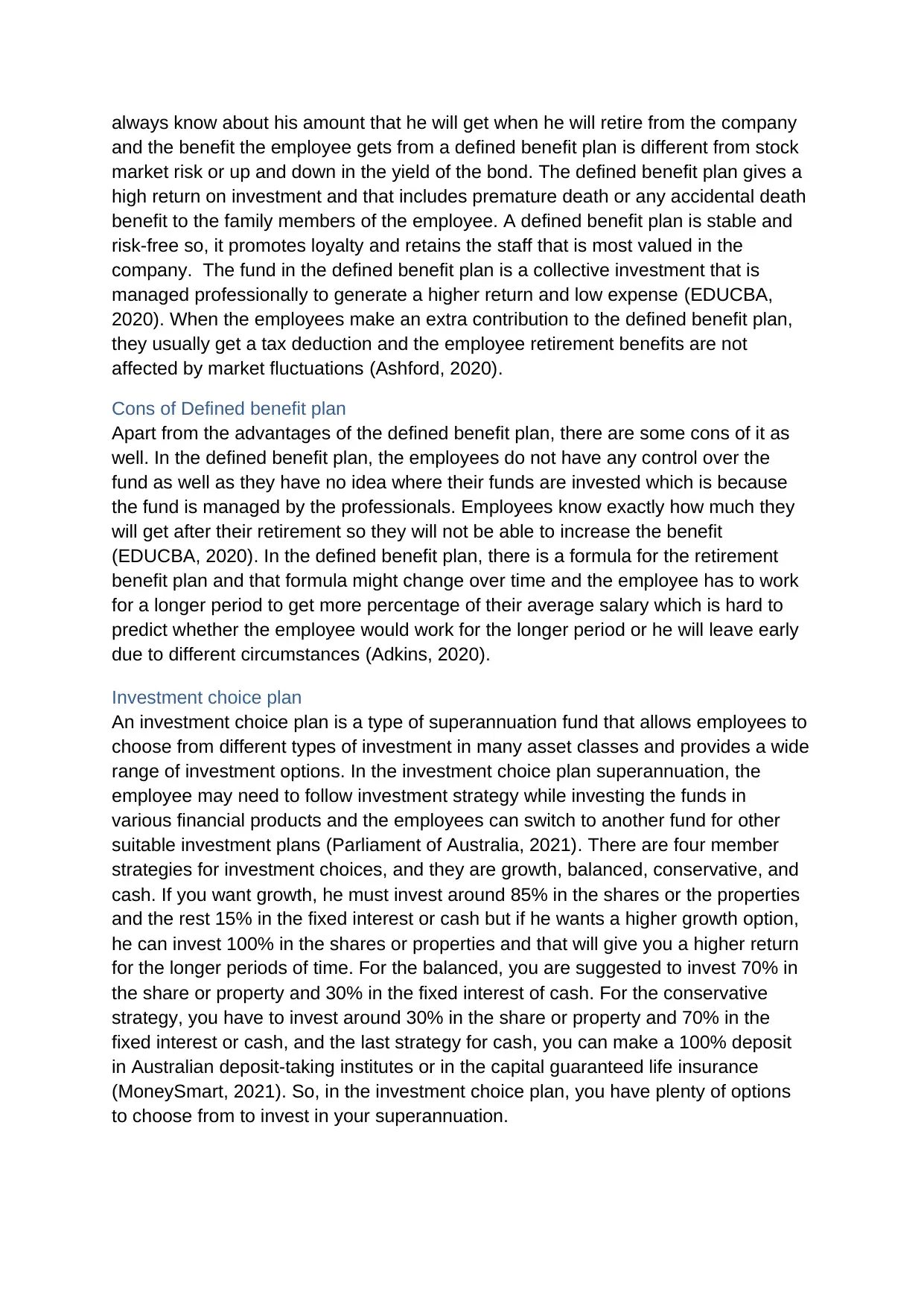
always know about his amount that he will get when he will retire from the company
and the benefit the employee gets from a defined benefit plan is different from stock
market risk or up and down in the yield of the bond. The defined benefit plan gives a
high return on investment and that includes premature death or any accidental death
benefit to the family members of the employee. A defined benefit plan is stable and
risk-free so, it promotes loyalty and retains the staff that is most valued in the
company. The fund in the defined benefit plan is a collective investment that is
managed professionally to generate a higher return and low expense (EDUCBA,
2020). When the employees make an extra contribution to the defined benefit plan,
they usually get a tax deduction and the employee retirement benefits are not
affected by market fluctuations (Ashford, 2020).
Cons of Defined benefit plan
Apart from the advantages of the defined benefit plan, there are some cons of it as
well. In the defined benefit plan, the employees do not have any control over the
fund as well as they have no idea where their funds are invested which is because
the fund is managed by the professionals. Employees know exactly how much they
will get after their retirement so they will not be able to increase the benefit
(EDUCBA, 2020). In the defined benefit plan, there is a formula for the retirement
benefit plan and that formula might change over time and the employee has to work
for a longer period to get more percentage of their average salary which is hard to
predict whether the employee would work for the longer period or he will leave early
due to different circumstances (Adkins, 2020).
Investment choice plan
An investment choice plan is a type of superannuation fund that allows employees to
choose from different types of investment in many asset classes and provides a wide
range of investment options. In the investment choice plan superannuation, the
employee may need to follow investment strategy while investing the funds in
various financial products and the employees can switch to another fund for other
suitable investment plans (Parliament of Australia, 2021). There are four member
strategies for investment choices, and they are growth, balanced, conservative, and
cash. If you want growth, he must invest around 85% in the shares or the properties
and the rest 15% in the fixed interest or cash but if he wants a higher growth option,
he can invest 100% in the shares or properties and that will give you a higher return
for the longer periods of time. For the balanced, you are suggested to invest 70% in
the share or property and 30% in the fixed interest of cash. For the conservative
strategy, you have to invest around 30% in the share or property and 70% in the
fixed interest or cash, and the last strategy for cash, you can make a 100% deposit
in Australian deposit-taking institutes or in the capital guaranteed life insurance
(MoneySmart, 2021). So, in the investment choice plan, you have plenty of options
to choose from to invest in your superannuation.
and the benefit the employee gets from a defined benefit plan is different from stock
market risk or up and down in the yield of the bond. The defined benefit plan gives a
high return on investment and that includes premature death or any accidental death
benefit to the family members of the employee. A defined benefit plan is stable and
risk-free so, it promotes loyalty and retains the staff that is most valued in the
company. The fund in the defined benefit plan is a collective investment that is
managed professionally to generate a higher return and low expense (EDUCBA,
2020). When the employees make an extra contribution to the defined benefit plan,
they usually get a tax deduction and the employee retirement benefits are not
affected by market fluctuations (Ashford, 2020).
Cons of Defined benefit plan
Apart from the advantages of the defined benefit plan, there are some cons of it as
well. In the defined benefit plan, the employees do not have any control over the
fund as well as they have no idea where their funds are invested which is because
the fund is managed by the professionals. Employees know exactly how much they
will get after their retirement so they will not be able to increase the benefit
(EDUCBA, 2020). In the defined benefit plan, there is a formula for the retirement
benefit plan and that formula might change over time and the employee has to work
for a longer period to get more percentage of their average salary which is hard to
predict whether the employee would work for the longer period or he will leave early
due to different circumstances (Adkins, 2020).
Investment choice plan
An investment choice plan is a type of superannuation fund that allows employees to
choose from different types of investment in many asset classes and provides a wide
range of investment options. In the investment choice plan superannuation, the
employee may need to follow investment strategy while investing the funds in
various financial products and the employees can switch to another fund for other
suitable investment plans (Parliament of Australia, 2021). There are four member
strategies for investment choices, and they are growth, balanced, conservative, and
cash. If you want growth, he must invest around 85% in the shares or the properties
and the rest 15% in the fixed interest or cash but if he wants a higher growth option,
he can invest 100% in the shares or properties and that will give you a higher return
for the longer periods of time. For the balanced, you are suggested to invest 70% in
the share or property and 30% in the fixed interest of cash. For the conservative
strategy, you have to invest around 30% in the share or property and 70% in the
fixed interest or cash, and the last strategy for cash, you can make a 100% deposit
in Australian deposit-taking institutes or in the capital guaranteed life insurance
(MoneySmart, 2021). So, in the investment choice plan, you have plenty of options
to choose from to invest in your superannuation.
Paraphrase This Document
Need a fresh take? Get an instant paraphrase of this document with our AI Paraphraser
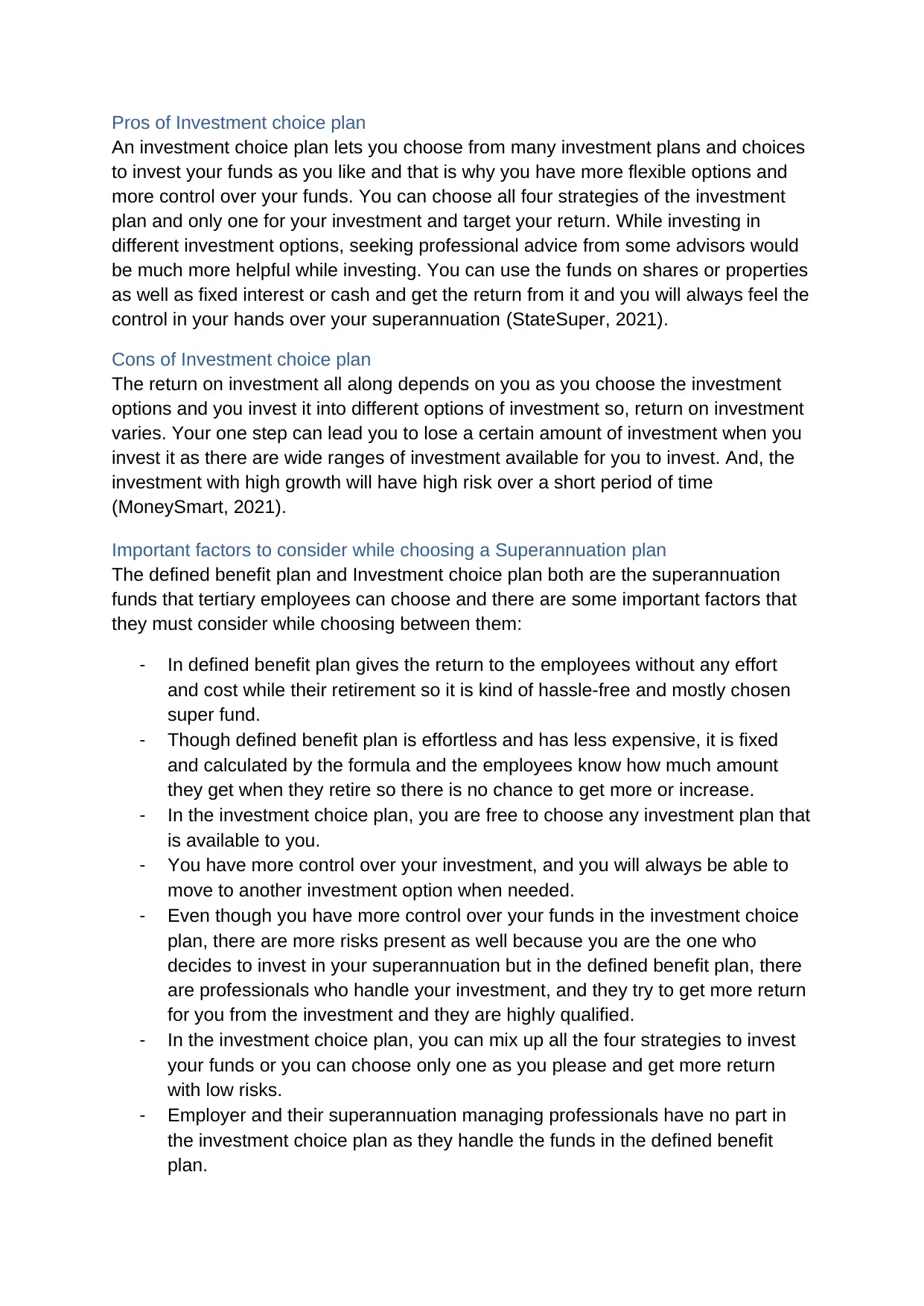
Pros of Investment choice plan
An investment choice plan lets you choose from many investment plans and choices
to invest your funds as you like and that is why you have more flexible options and
more control over your funds. You can choose all four strategies of the investment
plan and only one for your investment and target your return. While investing in
different investment options, seeking professional advice from some advisors would
be much more helpful while investing. You can use the funds on shares or properties
as well as fixed interest or cash and get the return from it and you will always feel the
control in your hands over your superannuation (StateSuper, 2021).
Cons of Investment choice plan
The return on investment all along depends on you as you choose the investment
options and you invest it into different options of investment so, return on investment
varies. Your one step can lead you to lose a certain amount of investment when you
invest it as there are wide ranges of investment available for you to invest. And, the
investment with high growth will have high risk over a short period of time
(MoneySmart, 2021).
Important factors to consider while choosing a Superannuation plan
The defined benefit plan and Investment choice plan both are the superannuation
funds that tertiary employees can choose and there are some important factors that
they must consider while choosing between them:
- In defined benefit plan gives the return to the employees without any effort
and cost while their retirement so it is kind of hassle-free and mostly chosen
super fund.
- Though defined benefit plan is effortless and has less expensive, it is fixed
and calculated by the formula and the employees know how much amount
they get when they retire so there is no chance to get more or increase.
- In the investment choice plan, you are free to choose any investment plan that
is available to you.
- You have more control over your investment, and you will always be able to
move to another investment option when needed.
- Even though you have more control over your funds in the investment choice
plan, there are more risks present as well because you are the one who
decides to invest in your superannuation but in the defined benefit plan, there
are professionals who handle your investment, and they try to get more return
for you from the investment and they are highly qualified.
- In the investment choice plan, you can mix up all the four strategies to invest
your funds or you can choose only one as you please and get more return
with low risks.
- Employer and their superannuation managing professionals have no part in
the investment choice plan as they handle the funds in the defined benefit
plan.
An investment choice plan lets you choose from many investment plans and choices
to invest your funds as you like and that is why you have more flexible options and
more control over your funds. You can choose all four strategies of the investment
plan and only one for your investment and target your return. While investing in
different investment options, seeking professional advice from some advisors would
be much more helpful while investing. You can use the funds on shares or properties
as well as fixed interest or cash and get the return from it and you will always feel the
control in your hands over your superannuation (StateSuper, 2021).
Cons of Investment choice plan
The return on investment all along depends on you as you choose the investment
options and you invest it into different options of investment so, return on investment
varies. Your one step can lead you to lose a certain amount of investment when you
invest it as there are wide ranges of investment available for you to invest. And, the
investment with high growth will have high risk over a short period of time
(MoneySmart, 2021).
Important factors to consider while choosing a Superannuation plan
The defined benefit plan and Investment choice plan both are the superannuation
funds that tertiary employees can choose and there are some important factors that
they must consider while choosing between them:
- In defined benefit plan gives the return to the employees without any effort
and cost while their retirement so it is kind of hassle-free and mostly chosen
super fund.
- Though defined benefit plan is effortless and has less expensive, it is fixed
and calculated by the formula and the employees know how much amount
they get when they retire so there is no chance to get more or increase.
- In the investment choice plan, you are free to choose any investment plan that
is available to you.
- You have more control over your investment, and you will always be able to
move to another investment option when needed.
- Even though you have more control over your funds in the investment choice
plan, there are more risks present as well because you are the one who
decides to invest in your superannuation but in the defined benefit plan, there
are professionals who handle your investment, and they try to get more return
for you from the investment and they are highly qualified.
- In the investment choice plan, you can mix up all the four strategies to invest
your funds or you can choose only one as you please and get more return
with low risks.
- Employer and their superannuation managing professionals have no part in
the investment choice plan as they handle the funds in the defined benefit
plan.
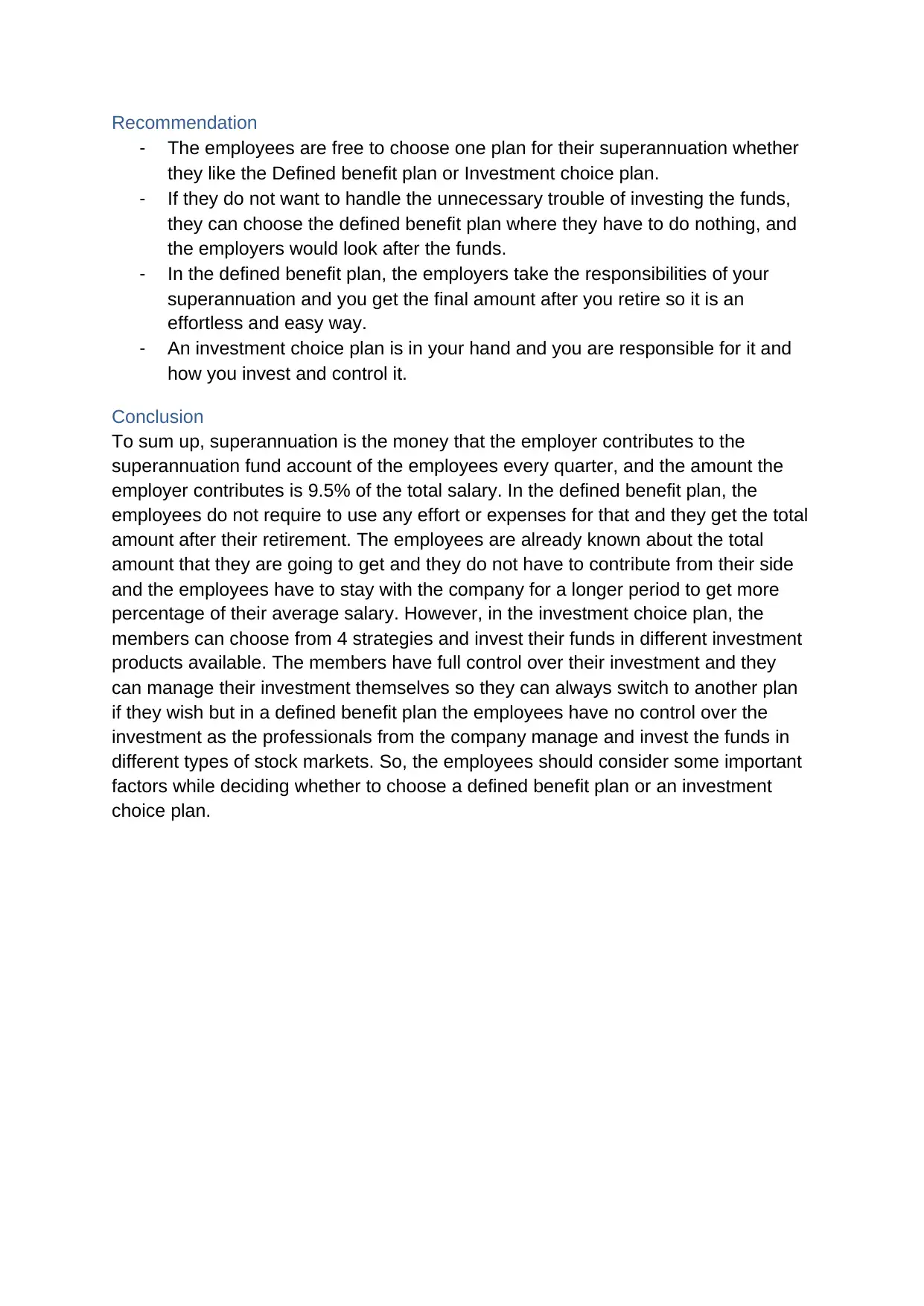
Recommendation
- The employees are free to choose one plan for their superannuation whether
they like the Defined benefit plan or Investment choice plan.
- If they do not want to handle the unnecessary trouble of investing the funds,
they can choose the defined benefit plan where they have to do nothing, and
the employers would look after the funds.
- In the defined benefit plan, the employers take the responsibilities of your
superannuation and you get the final amount after you retire so it is an
effortless and easy way.
- An investment choice plan is in your hand and you are responsible for it and
how you invest and control it.
Conclusion
To sum up, superannuation is the money that the employer contributes to the
superannuation fund account of the employees every quarter, and the amount the
employer contributes is 9.5% of the total salary. In the defined benefit plan, the
employees do not require to use any effort or expenses for that and they get the total
amount after their retirement. The employees are already known about the total
amount that they are going to get and they do not have to contribute from their side
and the employees have to stay with the company for a longer period to get more
percentage of their average salary. However, in the investment choice plan, the
members can choose from 4 strategies and invest their funds in different investment
products available. The members have full control over their investment and they
can manage their investment themselves so they can always switch to another plan
if they wish but in a defined benefit plan the employees have no control over the
investment as the professionals from the company manage and invest the funds in
different types of stock markets. So, the employees should consider some important
factors while deciding whether to choose a defined benefit plan or an investment
choice plan.
- The employees are free to choose one plan for their superannuation whether
they like the Defined benefit plan or Investment choice plan.
- If they do not want to handle the unnecessary trouble of investing the funds,
they can choose the defined benefit plan where they have to do nothing, and
the employers would look after the funds.
- In the defined benefit plan, the employers take the responsibilities of your
superannuation and you get the final amount after you retire so it is an
effortless and easy way.
- An investment choice plan is in your hand and you are responsible for it and
how you invest and control it.
Conclusion
To sum up, superannuation is the money that the employer contributes to the
superannuation fund account of the employees every quarter, and the amount the
employer contributes is 9.5% of the total salary. In the defined benefit plan, the
employees do not require to use any effort or expenses for that and they get the total
amount after their retirement. The employees are already known about the total
amount that they are going to get and they do not have to contribute from their side
and the employees have to stay with the company for a longer period to get more
percentage of their average salary. However, in the investment choice plan, the
members can choose from 4 strategies and invest their funds in different investment
products available. The members have full control over their investment and they
can manage their investment themselves so they can always switch to another plan
if they wish but in a defined benefit plan the employees have no control over the
investment as the professionals from the company manage and invest the funds in
different types of stock markets. So, the employees should consider some important
factors while deciding whether to choose a defined benefit plan or an investment
choice plan.
⊘ This is a preview!⊘
Do you want full access?
Subscribe today to unlock all pages.

Trusted by 1+ million students worldwide
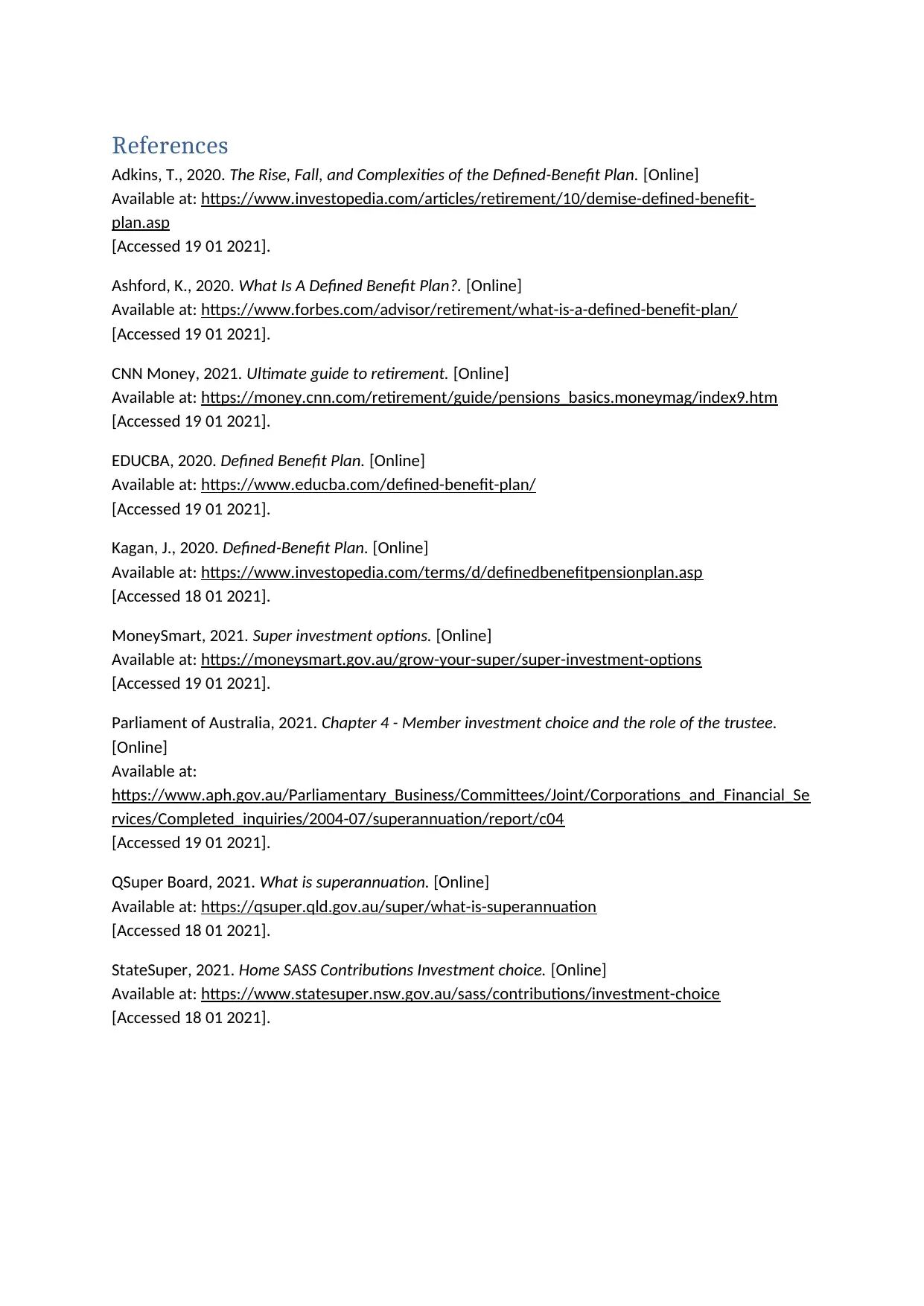
References
Adkins, T., 2020. The Rise, Fall, and Complexities of the Defined-Benefit Plan. [Online]
Available at: https://www.investopedia.com/articles/retirement/10/demise-defined-benefit-
plan.asp
[Accessed 19 01 2021].
Ashford, K., 2020. What Is A Defined Benefit Plan?. [Online]
Available at: https://www.forbes.com/advisor/retirement/what-is-a-defined-benefit-plan/
[Accessed 19 01 2021].
CNN Money, 2021. Ultimate guide to retirement. [Online]
Available at: https://money.cnn.com/retirement/guide/pensions_basics.moneymag/index9.htm
[Accessed 19 01 2021].
EDUCBA, 2020. Defined Benefit Plan. [Online]
Available at: https://www.educba.com/defined-benefit-plan/
[Accessed 19 01 2021].
Kagan, J., 2020. Defined-Benefit Plan. [Online]
Available at: https://www.investopedia.com/terms/d/definedbenefitpensionplan.asp
[Accessed 18 01 2021].
MoneySmart, 2021. Super investment options. [Online]
Available at: https://moneysmart.gov.au/grow-your-super/super-investment-options
[Accessed 19 01 2021].
Parliament of Australia, 2021. Chapter 4 - Member investment choice and the role of the trustee.
[Online]
Available at:
https://www.aph.gov.au/Parliamentary_Business/Committees/Joint/Corporations_and_Financial_Se
rvices/Completed_inquiries/2004-07/superannuation/report/c04
[Accessed 19 01 2021].
QSuper Board, 2021. What is superannuation. [Online]
Available at: https://qsuper.qld.gov.au/super/what-is-superannuation
[Accessed 18 01 2021].
StateSuper, 2021. Home SASS Contributions Investment choice. [Online]
Available at: https://www.statesuper.nsw.gov.au/sass/contributions/investment-choice
[Accessed 18 01 2021].
Adkins, T., 2020. The Rise, Fall, and Complexities of the Defined-Benefit Plan. [Online]
Available at: https://www.investopedia.com/articles/retirement/10/demise-defined-benefit-
plan.asp
[Accessed 19 01 2021].
Ashford, K., 2020. What Is A Defined Benefit Plan?. [Online]
Available at: https://www.forbes.com/advisor/retirement/what-is-a-defined-benefit-plan/
[Accessed 19 01 2021].
CNN Money, 2021. Ultimate guide to retirement. [Online]
Available at: https://money.cnn.com/retirement/guide/pensions_basics.moneymag/index9.htm
[Accessed 19 01 2021].
EDUCBA, 2020. Defined Benefit Plan. [Online]
Available at: https://www.educba.com/defined-benefit-plan/
[Accessed 19 01 2021].
Kagan, J., 2020. Defined-Benefit Plan. [Online]
Available at: https://www.investopedia.com/terms/d/definedbenefitpensionplan.asp
[Accessed 18 01 2021].
MoneySmart, 2021. Super investment options. [Online]
Available at: https://moneysmart.gov.au/grow-your-super/super-investment-options
[Accessed 19 01 2021].
Parliament of Australia, 2021. Chapter 4 - Member investment choice and the role of the trustee.
[Online]
Available at:
https://www.aph.gov.au/Parliamentary_Business/Committees/Joint/Corporations_and_Financial_Se
rvices/Completed_inquiries/2004-07/superannuation/report/c04
[Accessed 19 01 2021].
QSuper Board, 2021. What is superannuation. [Online]
Available at: https://qsuper.qld.gov.au/super/what-is-superannuation
[Accessed 18 01 2021].
StateSuper, 2021. Home SASS Contributions Investment choice. [Online]
Available at: https://www.statesuper.nsw.gov.au/sass/contributions/investment-choice
[Accessed 18 01 2021].
1 out of 7
Related Documents
Your All-in-One AI-Powered Toolkit for Academic Success.
+13062052269
info@desklib.com
Available 24*7 on WhatsApp / Email
![[object Object]](/_next/static/media/star-bottom.7253800d.svg)
Unlock your academic potential
Copyright © 2020–2025 A2Z Services. All Rights Reserved. Developed and managed by ZUCOL.




